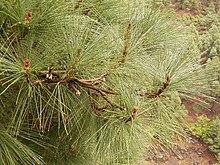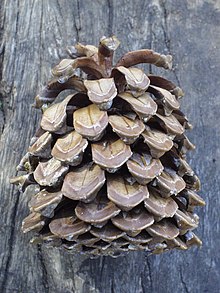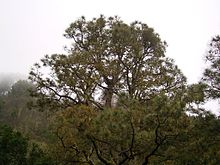Canary pine
| Canary pine | ||||||||||||
|---|---|---|---|---|---|---|---|---|---|---|---|---|

Canary pine ( Pinus canariensis ) |
||||||||||||
| Systematics | ||||||||||||
|
||||||||||||
| Scientific name | ||||||||||||
| Pinus canariensis | ||||||||||||
| C.Sm. |
The Canary Island pine ( Pinus canariensis ), and Canary pine called, is a plant of the genus of pine ( Pinus ) within the family of Pinaceae (Pinaceae). It is endemic to the Canary Islands . It is the economically most important tree species in the Canaries. The species is a natural symbol of the island of La Palma .
description
Habitus
The Canary Pine is an evergreen tree that reaches heights of 15 to 25 meters and a diameter of 50 to 100 centimeters at chest height . In the southwest of Tenerife there is a 60 meter high tree with a trunk diameter of 265 centimeters. This makes the Canarian pine the largest recent pine in the Old World . Free-standing trees have a broad and irregularly shaped crown . In dense stands it forms a narrow pyramidal crown. Young shoots are between 6 and 13 millimeters thick. It is able to drive trunks and branches out of the stumps after forest fires, for example . The service life is given as 250 to 300 years, in individual cases up to 600 years. The oldest example is the Pino de la Virgen on La Palma with about 800 years.
Buds and needles
The large and thick winter buds are egg-shaped to cylindrical in shape, pointed and not resinous. They are covered with brownish-red scales. These scales are 10 to 16 millimeters long and 4 to 5 millimeters wide and have a free, recurved tip. The edge is provided with long eyelashes.
The very flexible needles are close to the long shoots. There are three of them on short shoots 10 to 20 millimeters long . They are 15 and 30 centimeters long and around 1 millimeter wide. They are blue-green on young trees and grass-green on old trees. They are also noticeably shiny on old trees and hang over. The needles are pointed and finely sawn on the edges. The cross-section is three-sided, and there are 1 to 3 stomata on each side . The needles stay on the tree for around 2 to 3 years. With the help of the long needles, the species is able to "comb out" clouds of fog, which leads to additional precipitation through condensation (see fog condensation ). Precipitation amounts of around 2,500 mm per year are achieved over a small area.
Flowers, cones and seeds
The Canary Pine is single-sexed ( monoecious ). The flowering period extends from March to April. At the base of annual long shoots , up to 150 male cones can stand on an area of around 10 by 6 centimeters. At the beginning of the flowering period they are greenish yellow in color and around 3 centimeters long. As they fade, they turn reddish. The pollen is yellow. The female cones are usually solitary or in pairs, rarely in whorls at the tips of long shoots. They are greenish red in color and bend downwards after flowering. The short-stalked cones are around 7 to 18 inches long and 4 to 8 inches thick. They ripen in autumn of the 2nd to 3rd year and are then shiny brown-red in color. The cone scales are around 4 inches long and 2 inches wide. With regard to the journal case, a distinction is made between two types. With the first type, the sterile scales remain on the branch. In the second type, the entire cone will detach from the branch. The gray-brown to blackish and often spotted seeds are around 12 millimeters long and 6 millimeters wide. They are obovate and have a 12 to 25 millimeter long wing, the edge of which is slightly wavy. The thousand grain weight is between 62 and 169 grams. The seedlings usually have 7 to 9 long and thin cotyledons ( cotyledons )
bark
The thick gray to reddish brown trunk bark is deeply furrowed and torn open in scaly plates. In old trees, the bark can consist of up to 50 layers. On young twigs it is yellow and bare. It turns matt brown in the 2nd year. In forest fires, the bark does not char, but rather encrusts. Thanks to this fire protection mechanism, the Canary Islands pine drives out again after forest fires.
root
The Canary Pine forms a strong tap root that extends deep into the ground. Strong lateral roots are formed, which only stay close to the surface on shallow soils, but can also grow very deep on deep soils. The species enters into a mycorrhizal partnership with many types of fungus, including 14 types of crack fungi ( Inocybe ) .
Wood
The resinous, dark red-brown heartwood is surrounded by a light yellowish sapwood . The annual rings are clearly visible. The wood of the Canary Pine is heavy, hard and very durable compared to other pine species native to the Mediterranean region. With a wood moisture content of 12%, the sapwood has a bulk density of 0.60 to 0.75 g / cm³, a compressive strength of 53 N / mm² and a flexural strength of 116 N / mm². With a wood moisture content of 12%, the heartwood has a bulk density of 0.92 to 1.14 g / cm³, a compressive strength of 47 N / mm² and a flexural strength of 124 N / mm².
Endemic and monoculture
Since its existence in the Canary Islands, the Canary Pine has been subject to high evolutionary pressure as a result of the recurring volcanic eruptions and the devastating fires associated with them (according to Anke Jentsch, Research Area Disturbed Ecosystems). The endemic Canary Island pine resists the fires by protecting its tribal buds from the flames under its very thick bark. A short time after the end of the fire, the buds sprout again from the charred trunk. The pines thus dominated other species in fire-endangered forests.
In some areas of the pine forests on La Palma, natural monocultures have emerged, which occur very rarely in nature. The thick layer of pine needles that accumulates under the pines over time and that rot only slowly act as fire accelerators in a forest fire , preventing other species from growing in the area.
Chromosome number
The number of chromosomes is 2n = 24.
Distribution and location
The Canary Pine is endemic to the Canary Islands . You can find them on the islands of Gran Canaria , Tenerife , La Palma , La Gomera and El Hierro . The natural distribution area covers around 50,000 hectares of forest. The species is completely absent on the islands of Fuerteventura and Lanzarote . It is planted as an ornamental tree in the northern Mediterranean , the southern USA , South America , Australia and New Zealand . It is planted as a forest tree in North and South Africa.
The Canary Pine is a tree species from the dry, subtropical-Mediterranean climate, which in the Canaries is mainly characterized by the northeast trade wind. In winter the humidity is uniform and in summer there is a constant period of heat and drought. The mean annual temperatures are between 11 and 19 ° C. The extreme temperatures vary between −6 and 40 ° C. Extensive forests grow mainly in the fog cloud zone. The species needs an annual rainfall of at least 300 mm. Mainly Andosol - brown earth - and volcanic raw soils are settled. It is a pioneer tree species on young lava soils. The pH should be below 7.5. You can find them at altitudes of 300 to 2,300 meters. In Central Europe, the Canary Pine is not hardy.
The tree heather ( Erica arborea ) and the gale tree ( Myrica faya ) are mentioned as companion plants in lower elevations . In the middle zone, at altitudes from 1,400 to 1,900 meters, the goat clover species Cytisus proliferus predominates. At higher altitudes it is replaced by the sticky glandular gorse ( Adenocarpus viscosus ), by Adenocarpus foliolosus and by the Teideginster ( Cytisus supranubius ). The comfrey-leaved rockrose ( Cistus symphytifolius ) occurs increasingly as a companion plant, especially on forest fire and cleared areas .
use
The heartwood, also known as "tea wood", has been a sought-after building material for centuries. Ships, windmills , wine barrels, boxes, etc. were made from it. Many private and public buildings in the Canary Islands adorn balconies, doors, windows, ceilings and beams made of this robust material. In order to extract tar from the resin-rich wood for caulking the ships, ancient pine trees were charred in special ovens ( horno de brea ).
It is controversial how important the fog condensation water "combed out" by the needles is for the water balance of the islands, since a large part of this water runs off the surface. In the past, needle litter was used to pack the Musa acuminata banana cultivated in the Canaries . It is still used today as a bedding material in cattle stalls and chopped up as compost.
Diseases and pests
In its natural habitat, the Canary Islands pine is hardly threatened by diseases and pests. Occasionally the needles are attacked by a rust fungus from the genus Coleosporium . Planted stocks in India proved to be very susceptible to the bladder rust pathogen Cronartium himalayense . In South Africa the were root rot -causing fungus Rhizina undulata and needle mushroom Dothistroma pini proven. A weak resistance to the rust fungus Cronartium comandrae has been demonstrated in the USA . Populations in Italy are less frequently affected by the fall-off disease than other pine species. When the pine scale insect ( Matsucoccus josephi ) was attacked, the species reacted in Israeli cultivations with the formation of a wound periderm , which prevented the further development of the pest. The species is particularly susceptible to the pine processionary moth ( Thaumetopoea pityocampa ).
Forest fires, most of which are caused by humans, occur time and again, especially in forests over 40 years old. The badly rotting needle litter promotes the spread of the fire. Due to their thick bark, old trees usually survive these fires unscathed. They are also able to sprout from branches and trunks with long shoots .
Systematics
The Canary Pine is assigned to the sub-genus Pinus , the section Pinus and the subsection Pinaster within the genus of the pines ( Pinus ) . The number of chromosomes is 2n = 24. The closest related species is Pinus roxburghii , which is native to the Himalayas . It is likely that the two species have the same ancestors. A phylogenetic relationship with the pine tree ( Pinus pinea ) was established on the basis of DNA analyzes . In the natural location, different phenotypes are distinguished on the basis of shape, branching, crown formation and bark formation , which suggests a genetically determined variation. The morphological variation is particularly large in the cones, which depends on the altitude, temperature and humidity. It is still unclear whether the individual populations in the Canary Islands represent different races.
Hybrids
So far, an artificial crossing has only been successful with Pinus roxburghii , although intolerance reactions were noticeable. The seeds of the hybrids were only half as heavy as the seeds of the parent species.
literature
- BR Stephan: Pinus canariensis , in: P. Schütt et al .: Enzyklopädie der Holzgewächse , 2003. Loose-leaf collection with supplements
- Schütt, Weisgerber, Schuck, Lang, Stimm, Roloff: Lexicon of Conifers . Nikol, Hamburg 2008, ISBN 3-933203-80-5 , p. 335-344 .
Individual evidence
- ↑ Ley 7/1991, de 30 de April, de símbolos de la naturaleza para las Islas Canarias
- ↑ The Gymnosperm Database: Pinus canariensis
- ↑ a b c Schütt et al .: Lexicon of Conifers, p. 337
- ↑ a b c d Schütt et al .: Lexicon of Conifers, p. 340
- ↑ a b Schütt et al .: Lexicon of Conifers, pp. 337–338
- ↑ a b Schütt et al .: Lexicon of Conifers, p. 341
- ↑ Schütt et al .: Lexicon of Conifers, p. 339
- ↑ Schütt et al .: Lexicon of Conifers, p. 338
- ↑ Anke Jentsch, Faculty of Biology, Chemistry and Geosciences, Disturbance Ecology , University of Bayreuth.
- ↑ Roland Knauer: How the refreshment returns, nature regenerates itself after devastating fires, but can change significantly in the process , Die Welt, January 21, 2020.
- ^ Tropicos. [1]
- ↑ a b Schütt et al .: Lexicon of Conifers, p. 336
- ↑ Schütt et al .: Lexicon of Conifers, pp. 336–337
- ↑ Canary pine , La Palma Travel, September 7, 2015, accessed on July 8, 2019.
- ↑ Schütt et al .: Lexicon of Conifers, p. 343
- ↑ Schütt et al .: Lexicon of Conifers, pp. 341–342
- ↑ Schütt et al .: Lexicon of Conifers, pp. 340–341
- ↑ a b Schütt et al .: Lexicon of Conifers, pp. 339–340
Web links
- Pinus canariensis in the endangered Red List species the IUCN 2007. Posted by: A. Farjon, 2003. Accessed on March 23 of 2008.










